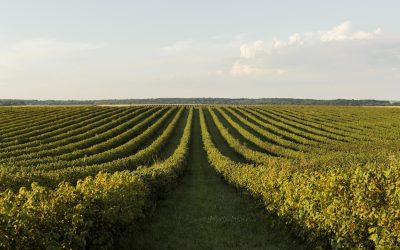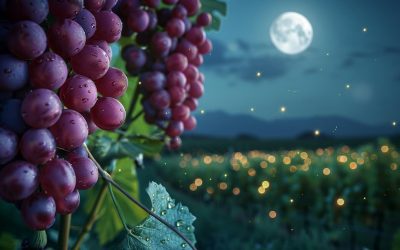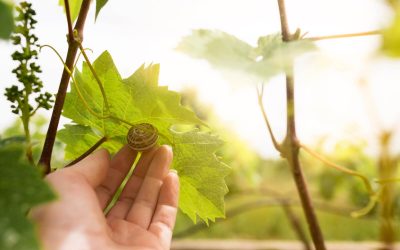When you bring a glass to your lips, you’re not just tasting a blend of grape varieties: you’re savoring the fruit of the labor of men and women, nurtured by a family heritage, driven by a quest for perfection, guided by curiosity and innovation.
These artisans of taste make essential decisions every day: pruning, harvesting by hand, choosing a precise moment when the grape expresses its full vitality… all acts imbued with memory, intuition, and high standards.
Traditional Culture, Foundation and Heritage
The Imprint of Terroir and Ancestral Practices
The vine develops within a geography, a climate, a soil: the terroir, shaped by generations of winemakers. The transmitted practices – goblet pruning, trellising, manual harvesting – embody a complete artisanal know-how, flexible, patient, and respectful of living things.
These ancestral techniques aim to ensure that each berry, at the time of its harvest, is at full physical and aromatic maturity: a subtle compromise between viticultural science and human sensibility.
Today: Modernity and Tradition Serving Life
In contemporary vineyards, technological modernity closely dialogues with soil- and biodiversity-friendly practices, stemming from deep viticultural traditions.
Precision Viticulture: Technology and Accuracy
Precision viticulture, based on drones, soil sensors, GPS, and satellite imagery, allows for fine and reactive monitoring. Winemakers can thus identify stressed areas, nascent diseases, or water needs with an unprecedented level of detail.
Specifically:
- Drones inspect vegetation cover and detect infections or water stress early.
- Sensors measure humidity, vine nutrition, and enable localized irrigation.
- Thanks to this information, phytosanitary treatments are applied only where necessary, reducing the use of chemicals.
The impact? Reduced inputs, improved soil health, resource preservation, and quality optimization. Viticulture becomes more sustainable, more precise, and healthier.
Soil-friendly Methods: Reasoned, Organic, and Biodynamic Farming
In parallel with this high-tech viticulture, more natural approaches are gaining ground:
- Reasoned agriculture / integrated pest management: it consists of limiting phytosanitary products to strictly necessary measures, by combining biological knowledge, careful monitoring of plots, and natural protections.
- Organic viticulture: it prohibits chemical fungicides, limiting treatments to authorized products (copper, sulfur…), with strict monitoring of ecological balances.
- Biodynamics: pushes organic farming further by considering the vine as a living system, integrating natural preparations (horn manure…), biodynamic compost, biodiversity, and planning work according to cosmic rhythms. The goal is to regenerate the soil, strengthen the vines, and produce grapes with purer aromatic expressions.
These methods take into account soil health via:
- Controlled or vegetative cover cropping to prevent erosion, improve soil structure, stimulate microbial life, while limiting herbicides.
- Agroforestry (hedges, trees on plots) promoting biodiversity, regulating temperature, sequestering carbon, organically enriching the soil, and providing refuge for beneficial fauna.
- Permaculture: a holistic system combining crops, animals, mulching, composting, autonomous micro-systems enabling sustainable harmony & increased resilience.
Resistant Grape Varieties: a Natural Response to Change
To reduce phytosanitary treatments, resistant grape varieties (Piwi, hybrids, Divico) are being experimented with. They exhibit genetic resistance to diseases (downy mildew, powdery mildew), while delivering quality aromatic profiles.
Their benefit? Drastically reducing chemical interventions – sometimes from 8 to 3 treatments per year – while maintaining satisfactory yields.
Combined Systems: the Strength of the Alliance between Technology and Ecology
The future of viticulture could rely on the synergy of approaches: systems combining precision viticulture (technology) with agroecology (biodiversity, organic, agroforestry).
Example: a drone detects a stressed area, a robot takes a sample that technology analyzes, and the biological or biodynamic solution is then applied locally.
This combination controls environmental impact while ensuring fruit quality, terroir expression, and conscious human action.
Tomorrow: Dialogues between Passion and Technology
Algorithms already help to optimize harvest dates, estimate yields, or predict aromatic profiles. This digital companion does not replace the artisan, but offers them new tools to enhance their intuition.
A wave of winemakers from other backgrounds (teachers, doctors, former city dwellers) are redefining the viticultural approach. They bring passion, curiosity, and sometimes challenge established methods.
A Growing Emphasis on Authenticity
Documentaries like “Somm: Into the Bottle ” show how much each bottle is a testament: to the history of its terroir, the winemaker’s action, their choices – a sensory as much as an intellectual invitation.
Illustrated labels, graphic signatures, transparent capsules are all ways to convey the personality of the estate. These visual choices strengthen the bond between the enthusiast and the producer.
What you perceive in your glass and what lies hidden within are two facets of the same world:
- Hands that cultivate life, with high standards and respect;
- A dialogue between tradition and innovation, between intuition and technology;
- A human adventure, where each bottle is a story, from the vines to your senses.
Next time you taste, dare to delve into these stories, intentions, evolutions. More than a wine, it’s an action, a passion, a promise you bring to your lips.






